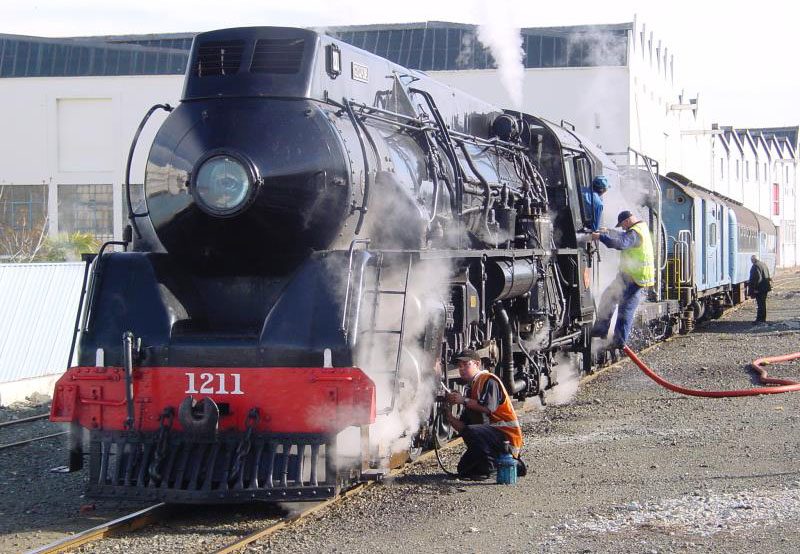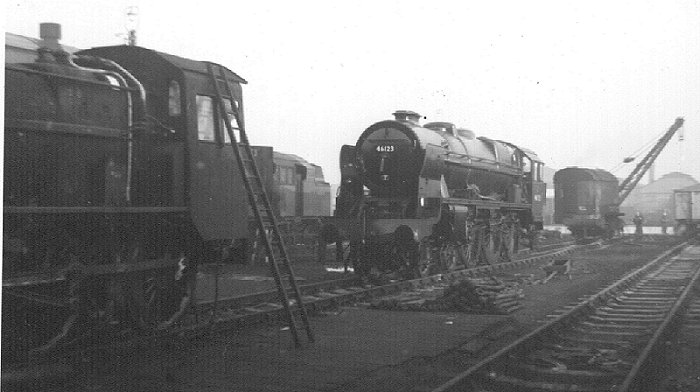|
LMS 6399 Fury
The London Midland and Scottish Railway (LMS) No. 6399 ''Fury'' was an unsuccessful British experimental express passenger locomotive. The intention was to save fuel by using high-pressure steam, which is thermodynamically more efficient than low-pressure steam. Overview Built in 1929 by the NBL (North British Locomotive Company) in Glasgow, it was one of a number of steam locomotives built around the world in the search for "Superpower steam". The locomotive was a joint venture between the London, Midland and Scottish Railway (LMS), with Henry Fowler as Chief Mechanical Engineer (C.M.E.) and The Superheater Company with the latter having responsibility for constructing the complex, 3 stage Schmidt-based boiler. The LMS provided a Royal Scot frame and running gear. However, Carney shows that the frames for Fury were not standard Royal Scot frames, but longer. For the complex boiler, John Brown & Company of Sheffield forged the special nickel-steel alloy high pressure drum ... [...More Info...] [...Related Items...] OR: [Wikipedia] [Google] [Baidu] |
North British Locomotive Co
The North British Locomotive Company (NBL, NB Loco or North British) was created in 1903 through the merger of three Glasgow locomotive manufacturing companies; Sharp, Stewart and Company (Atlas Works), Neilson, Reid and Company (Hyde Park Works) and Dübs and Company (Queens Park Works), creating the largest locomotive manufacturing company in Europe and the British Empire. Its main factories were located at the neighbouring Atlas and Hyde Park Works in central Springburn, as well as the Queens Park Works in Polmadie. A new central Administration and Drawing Office for the combined company was completed across the road from the Hyde Park Works on Flemington Street by James Miller (architect), James Miller in 1909, later sold to Glasgow Corporation in 1961 to become the main campus of North Glasgow College (now Glasgow Kelvin College). The two other Railway works in Springburn were St. Rollox railway works, owned by the Caledonian Railway and Cowlairs railway works, owned by t ... [...More Info...] [...Related Items...] OR: [Wikipedia] [Google] [Baidu] |
Crewe Works
Crewe Works is a British railway engineering facility located in the town of Crewe, Cheshire. The works, which was originally opened by the Grand Junction Railway in 1840, employed around 7,000 to 8,000 workers at its peak. In the 1980s, a lot of the engineering works were closed. Much of the site has been redeveloped but the remaining parts are owned and operated by French-owned multinational rolling stock manufacturer, Alstom SA. During the late 19th century, the London and North Western Railway used Crewe Works to produce many famous locomotives such as the Webb Jumbo class and the compounds, the Whale Experiment and Precursor classes, and the Bowen-Cooke Claughtons. In particular, Whale's 1912 superheated G1 Class developed from a locomotive introduced by Webb in 1892, lasted, in many cases until 1964, near the end of steam in 1968. After grouping, the works were taken over by London, Midland and Scottish Railway which was the successor to the LNWR. It was during ... [...More Info...] [...Related Items...] OR: [Wikipedia] [Google] [Baidu] |
Individual Locomotives Of Great Britain
An individual is that which exists as a distinct entity. Individuality (or self-hood) is the state or quality of being an individual; particularly (in the case of humans) of being a person unique from other people and possessing one's own needs or goals, rights and responsibilities. The concept of an individual features in diverse fields, including biology, law, and philosophy. Etymology From the 15th century and earlier (and also today within the fields of statistics and metaphysics) ''individual'' meant " indivisible", typically describing any numerically singular thing, but sometimes meaning "a person". From the 17th century on, ''individual'' has indicated separateness, as in individualism. Law Although individuality and individualism are commonly considered to mature with age/time and experience/wealth, a sane adult human being is usually considered by the state as an "individual person" in law, even if the person denies individual culpability ("I followed instruct ... [...More Info...] [...Related Items...] OR: [Wikipedia] [Google] [Baidu] |
High-pressure Steam Locomotives
In science and engineering the study of high pressure examines its effects on materials and the design and construction of devices, such as a diamond anvil cell, which can create high pressure. By ''high pressure'' is usually meant pressures of thousands (kilobars) or millions (megabars) of times atmospheric pressure (about 1 bar or 100,000 Pa). History and overview Percy Williams Bridgman received a Nobel Prize in 1946 for advancing this area of physics by several magnitudes of pressure (400 MPa to 40,000 MPa). The list of founding fathers of this field includes also the names of Harry George Drickamer, Tracy Hall, Francis P. Bundy, Leonid F. Vereschagin, and Sergey M. Stishov. It was by applying high pressure as well as high temperature to carbon that man-made diamonds were first produced as well as many other interesting discoveries. Almost any material when subjected to high pressure will compact itself into a denser form, for example, quartz, also called silica or silicon dio ... [...More Info...] [...Related Items...] OR: [Wikipedia] [Google] [Baidu] |
Experimental Locomotives
An experiment is a procedure carried out to support or refute a hypothesis, or determine the efficacy or likelihood of something previously untried. Experiments provide insight into cause-and-effect by demonstrating what outcome occurs when a particular factor is manipulated. Experiments vary greatly in goal and scale but always rely on repeatable procedure and logical analysis of the results. There also exist natural experimental studies. A child may carry out basic experiments to understand how things fall to the ground, while teams of scientists may take years of systematic investigation to advance their understanding of a phenomenon. Experiments and other types of hands-on activities are very important to student learning in the science classroom. Experiments can raise test scores and help a student become more engaged and interested in the material they are learning, especially when used over time. Experiments can vary from personal and informal natural comparisons (e ... [...More Info...] [...Related Items...] OR: [Wikipedia] [Google] [Baidu] |
NBL Locomotives
NBL may refer to: Business * Namibia Breweries Limited * National Bank Limited, the first private sector bank fully owned by Bangladeshi entrepreneurs * Nepal Bank Limited * Noble Energy, a former oil and natural gas exploration and production company with the NYSE ticker symbol NBL, now part of Chevron Corporation * North British Locomotive Company Science * n-Butyllithium, an organic compound * Neutral Buoyancy Laboratory, an astronaut training facility at NASA's Johnson Space Center * New Brunswick Laboratory Sports * National Badminton League (United Kingdom) * National Basketball League (other) * National Bicycle League (United States) * National Bowling League (United States) – defunct * North Bay League, now part of the North Coast Section (NCS) of the California Interscholastic Federation (CIF) Other uses * North Berwick Law, a volcanic plug in East Lothian, Scotland, United Kingdom * Northumberland, county in England, Chapman code * ''Nuestra Belleza ... [...More Info...] [...Related Items...] OR: [Wikipedia] [Google] [Baidu] |
LMS Royal Scot Class
The London, Midland and Scottish Railway (LMS) Royal Scot Class is a class of 4-6-0 express passenger locomotive introduced in 1927. Originally having parallel boilers, all members were later rebuilt with tapered type 2A boilers, and were in effect two classes. Background Until the mid-1920s, the LMS had followed the Midland Railway's small engine policy, which meant that it had no locomotives of sufficient power for its expresses on the West Coast Main Line. These trains were entrusted to pairs of LMS/MR Midland Compound 4-4-0s between Glasgow and , and a 4-6-0 locomotive of the LNWR Claughton Class, piloted by an LNWR George V 4-4-0, southwards to Euston station. The Operating and Motive Power Departments of the LMS were satisfied with the small engine policy. However, in 1926 the Chief Mechanical Engineer, Henry Fowler, began the design of a compound Pacific express locomotive. The management of the LMS, faced with disagreement between the CME and the other departments, o ... [...More Info...] [...Related Items...] OR: [Wikipedia] [Google] [Baidu] |
Ian Allan Publishing
Ian Allan Publishing was an English publisher, established in 1942, which specialised in transport books. It was founded by Ian Allan. In 1942 Ian Allan, then working in the public relations department for the Southern Railway at Waterloo station, decided he could deal with many of the requests he received about rolling stock by collecting the information into a book. The result was his first book, ''ABC of Southern Locomotives''. This proved to be a success, contributing to the emergence of trainspotting as a popular hobby in the UK, and leading to the formation of the company.Ian Allan…the man who launched a million locospotters ''The Railway Magazine'' issue 1174 February 1999 pages 20-27 The company grew from a small producer of books for train enthusiasts and spotters to a large transport publisher. Each year it published books covering subjects such as military and civil aviation, naval and maritime topics, buses, trams, trolleybuses and steam railways, including hi ... [...More Info...] [...Related Items...] OR: [Wikipedia] [Google] [Baidu] |
PLM 241 B 1
The PLM 241 B 1 was a high-pressure steam locomotive built in 1929 for the PLM (Chemins de fer de Paris à Lyon et à la Méditerranée) using the Schmidt high-pressure system. It was a 4-cylinder compound design. The manufacturer was Henschel & Sohn of Germany; it was most unusual for a French railway to buy German technology, there being somewhat less than total trust of Germany at the time. Schmidt and Henschel seem to have been the only sources of suitable technology. Only one was built. The locomotive was scrapped in 1936. *Boiler: 3-stage boiler; high pressure circuit: 110 kp/cm² (10.8 MPa, 1,560 psi Psi, PSI or Ψ may refer to: Alphabetic letters * Psi (Greek) (Ψ, ψ), the 23rd letter of the Greek alphabet * Psi (Cyrillic) (Ѱ, ѱ), letter of the early Cyrillic alphabet, adopted from Greek Arts and entertainment * "Psi" as an abbreviation ...)' secondary circuit: 58 kp/cm²; low-pressure circuit: 13 kp/cm² *Power: 2530 hpi (1.89 MW) *Speed (attained) 110 ... [...More Info...] [...Related Items...] OR: [Wikipedia] [Google] [Baidu] |
4-8-2
Under the Whyte notation for the classification of steam locomotives, represents the wheel arrangement of four leading wheels, eight powered and coupled driving wheels and two trailing wheels. This type of steam locomotive is commonly known as the Mountain type. Overview The Colony of Natal in South Africa and New Zealand were innovators of the Mountain wheel arrangement. The Natal Government Railways (NGR) placed in service the first tank engines with the 4-8-2 arrangement, and the NGR was also first to modify tender locomotives to use a 4-8-2 wheel arrangement. The New Zealand Railways Department (NZR) introduced the first tender locomotives designed and built as 4-8-2. In 1888, the Natal Government Railways placed the first five of its eventual one hundred Class D tank locomotives in service. The locomotive was designed by William Milne, the locomotive superintendent of the NGR from 1877 to 1896, and was built by Dübs & Company. This was the first known use of the whe ... [...More Info...] [...Related Items...] OR: [Wikipedia] [Google] [Baidu] |






.jpg)